How to build a medieval castle
The Norman conquest of England led to a boom in the construction of castles, but the process of creating a fortress from scratch is not so simple.

Bodiam Castle in East Sussex County, founded in 1385
1) Carefully select a site for construction.
It is imperative to build your castle on the dais and at a strategic point.
Locks were usually built on natural elevations, and were usually equipped with a link to the external environment, such as a ford, bridge or passage.
')
Historians have rarely been able to find evidences of contemporaries concerning the choice of a place for building a castle, but they still exist. On September 30, 1223, the 15-year-old King Henry III arrived in Montgomery with his army. The king, who had successfully carried out a military campaign against the Welsh prince Llywelyn ap Yorvert , was going to build a new castle in this area to ensure security on the border of his possessions. The English carpenters were tasked to prepare the wood a month before, but the king’s advisors had just now decided where to build the castle.

Montgomery Castle, when it began to be built in 1223, was located on an elevation
After a thorough review of the area, they chose a point on the very edge of the ledge above the valley of the River Severn. According to the chronicler Roger Wendoversky, this position "seemed impregnable to anyone." He also noted that the castle was created "for the security of the region from the frequent attacks of the Welsh".
Tip : identify the places where the topography rises above transport routes: these are natural places for castles. Keep in mind that the design of the castle is determined by the place of construction. For example, the castle on the ledge of the exposed rocks will be a dry moat.
2) Develop a workable plan
You will need a master bricklayer who can draw plans. Also useful engineer, well-versed in weapons.
Experienced soldiers may have their own ideas about the design of the castle, in the sense of the shapes of its buildings and their location. But it is unlikely they will have the knowledge of the level of specialists in design and construction.
To implement the idea, a master bricklayer was required - an experienced builder whose distinguishing feature was the ability to draw a plan. Understanding practical geometry, he used simple tools such as a ruler, a square, and a compass to create architectural plans. The masons-masons presented a drawing with a building plan for approval, and during construction controlled its construction.

When Edward II ordered the construction of a tower in Narsboro, he personally approved plans and demanded reports on the construction
When Edward II in 1307 began building a huge residential tower at Narsborough Castle in Yorkshire for his favorite Pierce Gaveston , he not only personally approved the plan created by London-based mason Hugh Tichmarshevsky — probably made in the form of a drawing — but also required regular construction reports . From the middle of the XVI century, a new group of professionals, called engineers, increasingly began to take on the role in developing plans and building fortifications. They had technical knowledge about the use and power of guns, both for defense and for attacking locks.
Tip : plan loopholes to ensure a wide angle of attack. Give them a shape in accordance with the weapon used: archers with large bows need big slopes, crossbowmen need less.
3) Hire a large group of experienced workers.
You will need thousands of people. And not necessarily all of them will come of free will.
For the construction of the castle required tremendous efforts. We have no documentary evidence of the construction of the first castles of England since 1066, but from the scale of many castles of that period it becomes clear why some chronicles say that the British were under the yoke of building castles for their Norman conquerors. But from the later time of the Middle Ages some estimates with detailed information reached us.
During the invasion of Wales in 1277, King Edward I began building a castle in Flint, northeastern Wales. It was erected quickly, thanks to the rich resources of the crown. A month after the start of work, in August, 2,300 people were attracted to the construction, including 1,270 excavators, 320 woodcutters, 330 carpenters, 200 bricklayers, 12 blacksmiths and 10 coal yards . All of them were driven from the surrounding lands under an armed escort, who looked to ensure that they did not deserve construction.
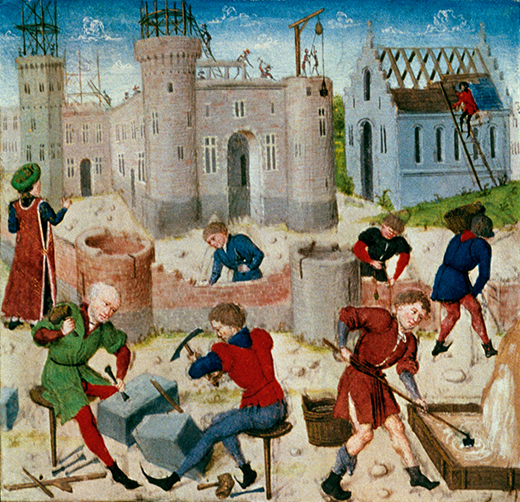
From time to time to the construction could attract foreign experts. For example, millions of bricks for the restructuring of the Tattershall castle in Lincolnshire in the 1440s were put by someone Baldwin “Docheman”, or Dutchman, that is, “Dutchman” - obviously a foreigner.
Tip : depending on the size of the workforce and the distance that she had to overcome, it may be necessary to ensure that they live at the construction site.
4) Secure the construction site
Unfinished castle on the territory of the enemy is very vulnerable to attack.
To build a castle in enemy territory, you need to protect the construction site from attacks. For example, you can enclose a building with wooden fortifications or a low stone wall. Such medieval defense systems sometimes remained after the construction of the building as an additional wall, such as, for example, in the castle of Bomaris, the construction of which was begun in 1295.
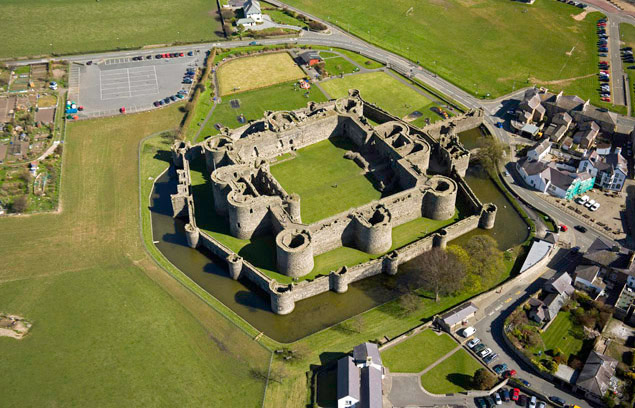
Bomaris (eng. Beaumaris, Wall. Biwmares) - a city on the island of Anglesey, Wales.
Also important is a secure connection with the outside world for the delivery of building materials and supplies. In 1277, Edward I dug a canal to the River Kluid directly from the sea and to the location of its new castle in Rüdlan. The outer wall, built to protect the construction site, reached the berths on the banks of the river.
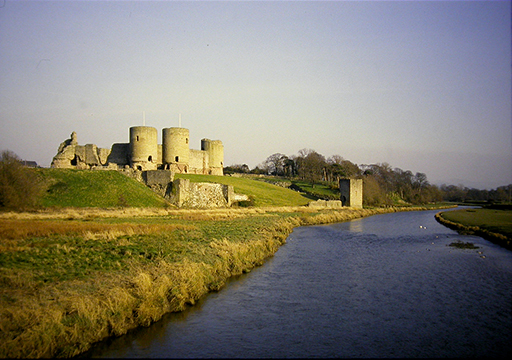
Rudlan Castle
Security issues may arise from a major overhaul of an existing lock. When Henry II rebuilt Dover Castle in the 1180s, all the works were carefully planned out so that the fortifications provided protection for the entire duration of the repair. According to the surviving decrees, work with the inner wall of the castle began only when the tower was already sufficiently repaired so that the guard could be on duty there.
Tip : building materials for building a castle are large and voluminous. If possible, it is better to transport them by water, even if you need to build a dock or canal.
5) Prepare the landscape
When building a castle, you may have to move an impressive amount of land, which is expensive.
It is often forgotten that the fortifications of the castle were built not only at the expense of architectural techniques, but also at the expense of landscape design. Huge resources were allocated for the movement of land. The scale of the Norman land works can be considered outstanding. For example, according to some estimates, the embankment erected in 1100 around the castle of Pleša in Essex required 24,000 person-days.
Some aspects of working with the landscape required serious skills, especially the creation of moats with water. When Edward I rebuilt the Tower of London in the 1270s, he hired a foreign specialist, Walter Flandersky, to create a huge tidal moat. Digging trenches under his leadership cost £ 4,000, a staggering amount, almost a quarter of the cost of the entire project.
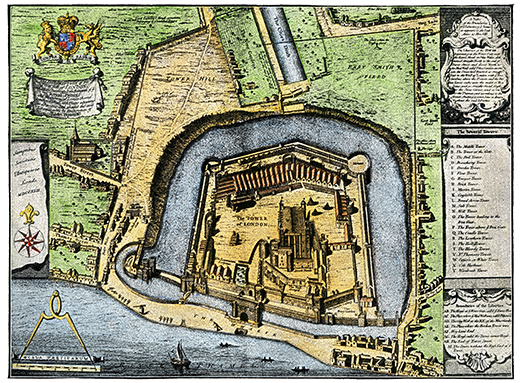
An engraving of the 18th century with a plan of the Tower of London in 1597 shows how much land had to be moved to build moats and ramparts.
With the increasing role of cannons in siege art, the earth began to play an even more important role as an absorber of cannon shots. Interestingly, the experience in moving large volumes of land allowed some engineers, specialists in fortifications, to find work as a designer of gardens.
Tip : Reduce time and costs by digging out masonry for the castle walls from the moats around it.
6) Lay the foundation
Carefully bring the bricklayer plan to life.
Using the ropes of the desired length and pegs, it was possible to designate the foundation of the building on the ground in full size. After the ditches for the foundation had been dug out, work began on the masonry. To save the responsibility for the construction was assigned to a senior bricklayer instead of a master bricklayer. The masonry in the Middle Ages was usually measured in childbirth , one English genus = 5.03 m. In Warkuerte in the county of Northumberland, one of the most difficult bashe stands on the lattice of the genera, possibly for the purpose of calculating construction costs.
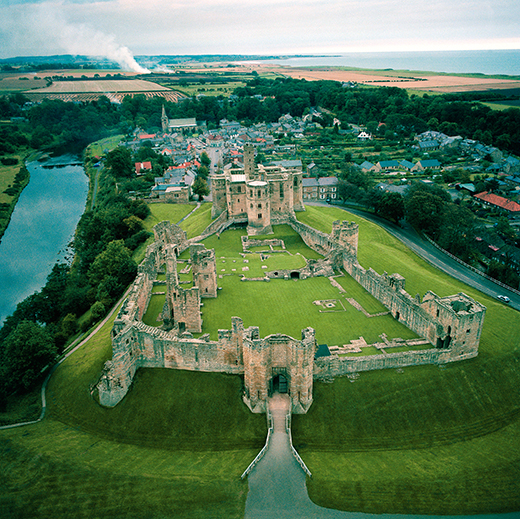
Castle Warkworth [Warkworth]
Often the construction of medieval castles was accompanied by detailed documentation. In 1441–42, the tower of Tutbury Castle in Staffordshire was destroyed, and a plan for its successor was made on the ground. But Prince Stafford was unhappy for some reason. The king’s mason, Robert of Westerly, was sent to Tathbury, where he held a meeting with two senior masons to develop a new tower at a new location. Then Westerly left, and for the next eight years a small group of workers, including four junior masons, built a new tower.
Senior bricklayers could be attracted to confirm the quality of work, as was the case at Kuling Castle in Kent, when royal mason Heinrich Yewel assessed work carried out from 1381 to 1384. He criticized deviations from the original plan and rounded the estimate down.
Tip : do not let the master bricklayer deceive yourself. Make him make such a plan so that it is easy to make an estimate.
7) Strengthen your castle
Complete the construction of complex fortifications and specialized wooden structures.
Until the 12th century, fortifications of most castles consisted of earth and logs. And although later the advantage was given to stone buildings, the tree remained a very important material in medieval wars and fortifications.
Stone castles prepared for attacks by adding special fighting galleries along the walls, as well as shutters, which could close the gaps between the teeth to protect the defenders of the castle. All this was made of wood. Heavy weapons used to protect the castle, catapults and heavy crossbows, sprygaldy , also built of wood. Artillery was usually developed by a highly paid professional carpenter, sometimes bearing the title of engineer, from the Latin "ingeniator".
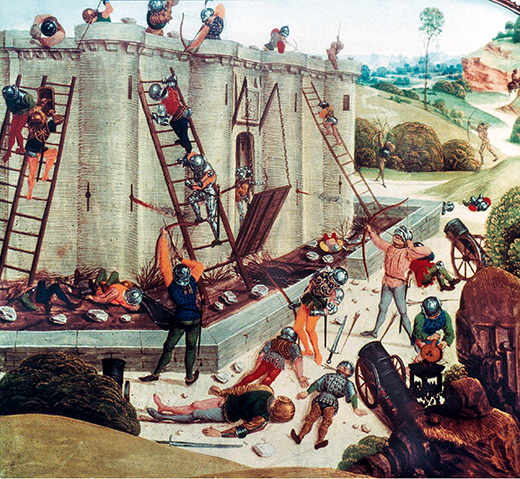
Storm of the castle, drawing of the XV century
Such experts were not cheap, but as a result could cost their weight in gold. This, for example, happened in 1266, when Kenilworth Castle in Warwickshire County resisted Henry III for almost six months with catapults and water protection.
There are records of hiking castles, completely made of wood - they could be carried with them and erected as needed. One such was built for the French invasion of England in 1386, but the Calais garrison captured it along with the ship. According to the description, it consisted of a wall of logs 20 feet high and 3000 steps long. Every 12 steps, there was a 30-foot tower capable of sheltering up to 10 soldiers, and there was unspecified protection for the shooters in the castle.
Tip : Oak wood becomes stronger over the years, and working with it is easiest when it is green. Top tree branches are easy to transport and shape.
8) Provide water and sewage
Do not forget about the "amenities". You will appreciate them in case of a siege.
The most important aspect for the castle was effective access to water. It could be wells that supply water to certain buildings, such as a kitchen or a stable. Without a detailed acquaintance with the medieval mines of wells it is difficult to give them their due. For example, in Beeston Castle in Cheshire there is a well with a depth of 100 m, the top 60 m of which are lined with a cut stone.
There is some evidence of the existence of sophisticated water pipes that brought water to the apartments. The Dover Castle Tower has a lead pipe system that delivers water to the rooms. She was fed from a well with a winch, and possibly from a rainwater harvesting system.
Effective elimination of human waste was another problem for castle developers. Restrooms were collected in one place of buildings so that their mines were emptied in one place. They were located in short corridors that delayed odors, and were often equipped with wooden seats and removable covers.
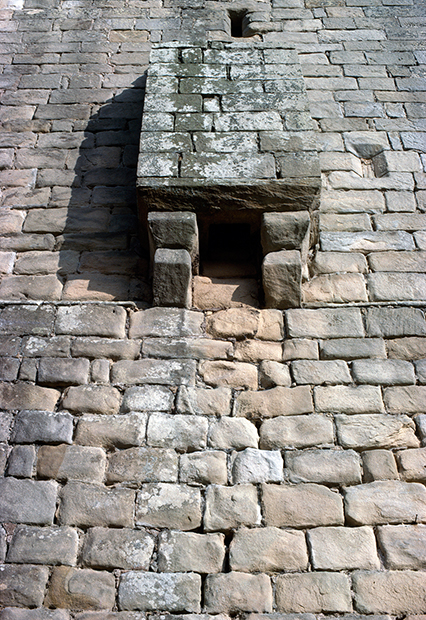
Room for thought in the castle Chipchase
Today it is widely believed that toilets used to be called “wardrobes”. In fact, the lexicon for toilets was extensive and colorful. They were called gongs or gangs (from the Anglo-Saxon word for "the place to go"), nooks and jakes (the French version of "John").
Advice : ask the mason master to plan comfortable and secluded latrines outside the bedroom, following the example of Henry II and Dover Castle.
9) Decorate as needed
The castle not only has to be well guarded - its residents, possessing high status, demanded a certain chic.
During the war, the castle must be defended - but it also serves as a luxury home. The noble gentlemen of the Middle Ages expected that their home would be both comfortable and richly furnished. In the Middle Ages, these citizens traveled with attendants, things and furniture from one residence to another. But home interiors often had fixed decorative features, for example, stained glass windows.
Henry III's tastes in the setting are recorded very carefully, with interesting and engaging details. In 1235-36, for example, he ordered that his hall at Winchester Castle be decorated with images of a world map and wheels of fortune. Since then, these decorations have not been preserved, but the well-known round table of King Arthur, created perhaps between 1250 and 1280, has remained in the interior.
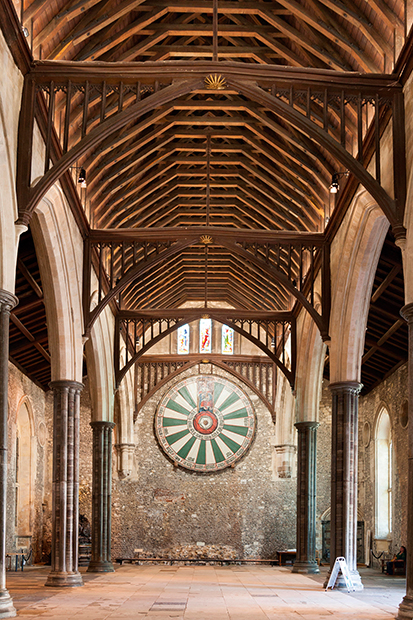
Winchester Castle with King Arthur's round table hanging on the wall
A large area of castles played an important role in the luxurious life. Parks were created for the implementation of hunting - jealously guarded privileges of aristocrats; gardens were also in demand. The description of the construction of the Kirby Maxlo Castle in Leicestershire that has come down to us says that its owner, Lord Hastings, began to set up gardens at the very beginning of the construction of the castle in 1480.
In the Middle Ages, they also loved rooms with beautiful views. One of the groups of rooms of the XIII century in the castles of Leeds in Kent, Korf in Dorset and Chepstow in Monmotshire was named gloriettes (from French. Gloriette - diminutive of the word glory) for their magnificence.
Tip : the interior of the castle should be luxurious enough to attract visitors and friends. Entertainment can win battles without having to expose themselves to the dangers of combat.
Source: https://habr.com/ru/post/401205/
All Articles